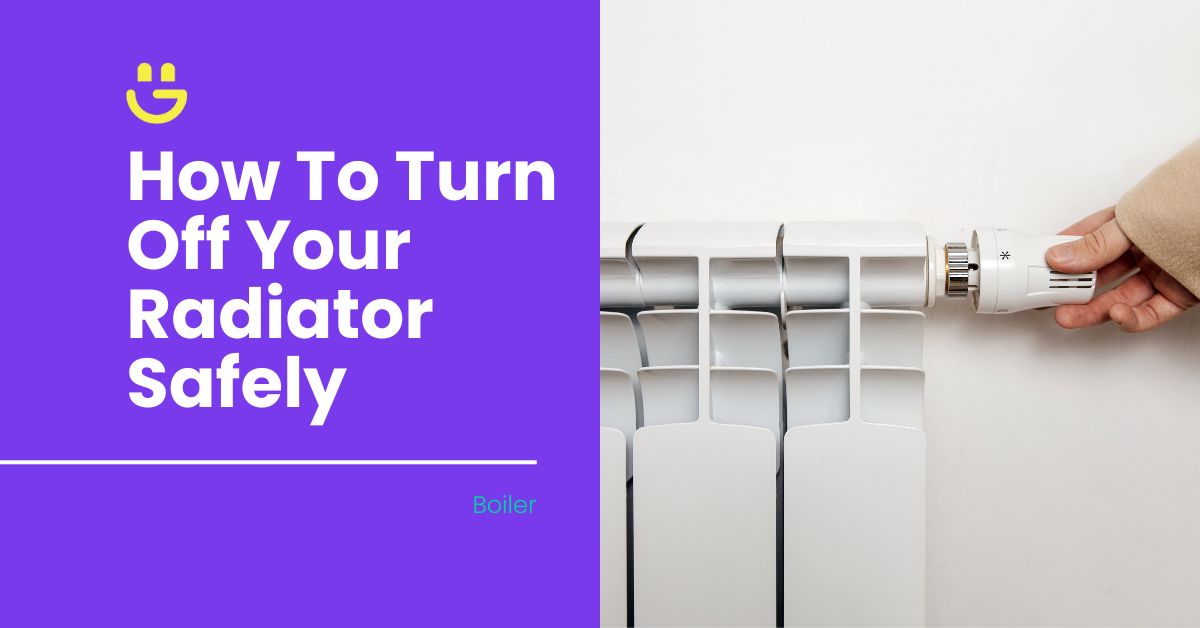Last Updated on November 14, 2025
Your home probably has a lot of radiators, and they can be a saving grace during the chill of winter. But there are times when you may want to turn off a radiator. Perhaps you’re going on holiday for a while, or the seasons have changed and there are blistering hot days. Can you turn a radiator off? More importantly, should you turn it off? And, if so, how can you turn a radiator off safely?
We’re going to explore turning off your radiators and the importance of following proper procedures to ensure you remain completely safe and avoid any mishaps. We’ll also look at how it affects your central heating system and what risks to avoid.
Contents
Understanding Radiator Valves
Radiator valves are similar to taps. They open and close. When open, they allow the flow of hot water through.
Different radiator valve types, such as manual, thermostatic, and lockshield valves, each have their own benefits and ways to operate.
- Manual valves can be manually turned on, off, or somewhere in between. They are good for rooms that require constant heat. For energy efficiency, you would need to manually switch the valves on and off when the heat is needed. Therefore, they need constant adjusting.
- Thermostatic valves shut off the flow of hot water to the radiator when the room has reached the correct temperature. The radiator valve stays closed until the temperature drops, and then it lets the water flow through again. Each room can have a different temperature setting on the radiator valves.
- A lockshield valve has a plastic cap placed on it to ensure that it’s not accidentally modified. It is found on the return pipe, which returns water to the boiler.
It’s important to know which valves you have so that you know how to turn off a radiator accordingly.
When to turn off or when to isolate
There is a difference between shutting a radiator off and isolating a radiator. Shutting it off stops the water from heating within the radiator. This involves the thermostatic radiator valve.
Isolating radiators, on the other hand, means turning off a radiator’s heat and water flow, which requires turning off two valves, one of which is the lockshield valve.
Sometimes, you’ll need to turn your radiators off to save energy. Other times, you may need to isolate a radiator for maintenance reasons, like when there’s a leak. If maintenance is being done, it’s extremely important to ensure that the radiator valves are completely shut before any work can commence.
If you mistakenly isolate a radiator instead of shutting it off, it could cause an imbalance in the system or even cause strain on the boiler. That’s also why it is so important to know how to balance radiators.
How To Turn Off A Radiator
To turn off your radiator, you need to first identify which valves you have. Once you have identified the radiator valves as being either thermostatic or manual, you can proceed to turn off the radiator.
With a thermostatic valve
Thermostatic radiators are self-regulating, so they control the flow of hot water to regulate the temperature in the room.
You will generally find thermostatic valves on the side of the radiator, towards the bottom. It’s usually the valve on the side that is closest to the boiler. They are easily recognisable because they have numbers on the valves.
To turn the radiator off, turn the thermostatic valve clockwise until you reach zero. This is the off position. To turn the radiator back on, turn the valve anti-clockwise.
If you’re going to be away for a while, you could use the frost prevention mode, which will keep the radiator on without producing excess heat and also prevent freezing in the pipes. Frost prevention is very important to avoid burst pipes. This mode is found on the radiator valve, next to zero.
How to turn off a radiator with a manual valve
Manual valves are, obviously, switched on and off manually.
1. Locate the Manual Valve: Find the manual valve on your radiator, typically located at the bottom left or right corner.
2. Turning Off the Radiator: To turn off your radiator, rotate the valve clockwise until it reaches the lowest setting. Then, slightly turn it back counterclockwise to avoid fully closing it. This step is essential to prevent water inside the radiator from freezing, which could damage pipes or radiator parts. Unlike thermostatic radiator valves (TRVs), manual valves do not have built-in frost protection.
3. Lowering the Heat: If you only want to reduce the heat, adjust the valve to a lower setting rather than turning it off entirely. For guidance on setting temperatures in unused rooms or general precautions, consult the manufacturer’s instructions.
Preventing freezing in pipes
There are several risks attached to turning off a radiator completely.
With radiators turned off, your boiler may need to work harder so that your central heating system can provide enough heat for your home. This could cost more money in the long run.
Another risk is that without hot water flowing through the pipes, the water in the pipes and radiator could freeze. This is potentially hazardous, as frozen water expands, so the pipes could burst, which could cause water damage.
Here are a few tips to prevent freezing or ruptures in the pipes:
- Drain the water from any radiators or pipes if they will be out of use for a while.
- Instead of a complete shutdown, leave the radiator valve slightly open and allow a trickle of water through. This will prevent freezing.
- Insulate exposed pipes to keep them from freezing.
How To Isolate A Radiator
When you isolate a radiator, you are completely stopping the water flow. This disconnects the radiator from the rest of the heating system. You may need to do this if you are replacing the radiator. Radiators may also need to be isolated when you are redecorating a room and need to paint the walls.
If it’s possible, turn off your central heating first before you follow the below steps to isolate a radiator.
With a thermostatic valve
If you have thermostatic radiator valves, you need to turn the thermostatic valve clockwise until it reaches zero. This will turn off the water flow, and the heat will stop.
Then you need to turn off the lockshield valves. Remove the lockshield valve cap. It may just pull off, or you may need to unscrew it. Then, grab your pliers and turn the lockshield valve in a clockwise motion until it stops turning.
Lastly, drain the radiator so no water will leak out.
You can use a decorator’s cap to complete the isolation. Also known as a radiator valve cap, it is a piece of plastic that can temporarily protect the thermostatic radiator valve. It would also protect it from any paint splatters if you are redecorating, or any dust or damage that could harm the valves.
With a manual valve
Turn the valve clockwise until it stops. This will stop the water from flowing into the radiator.
Then you need to turn off the lockshield valves. Remove the lockshield valve cap. It may just pull off, or you may need to unscrew it. Then grab your pliers and turn the lockshield valve clockwise until it stops turning.
Lastly, drain the radiator so no water will leak out.
Remember to always be careful when working with lockshield valves. Never overtighten them, as this could damage the valve seals. Always use the correct tools when dealing with lockshield valves to reduce the risk of damage to the radiator and harm to yourself.
Using isolators
With isolators, you can single out a radiator, disrupting the water flow to a specific radiator.
There are thermostatic isolator valves and manual isolator valves.
Thermostatic isolator valves allow you to set a temperature for a radiator or switch it off completely, while manual ones offer an on/off function.
To install a thermostatic isolator valve, you need to replace the existing thermostatic valve. Follow the user manual for instructions.
To install a manual isolator valve, you would need to shut off the central heating system and then screw the manual isolator into the existing pipework. Again, it’s important to follow the manufacturer’s guidelines on how to install these.
Additional Considerations
While reading this, you’ve probably realised that thermostatic radiator valves have some great benefits, and now you may want to do a slight upgrade on your radiator valves.
Replacing manual valves with thermostatic radiator valves
There may be times when replacing manual valves with thermostatic valves is the best course of action, like when there’s uneven heating between rooms or manual adjustments have become inconvenient and time-consuming. It could even be because of energy-saving efforts.
Make sure to read our guide on the best thermostatic radiator valves to make the right choice for your home.
Using radiator covers
[Radiator covers] are great for adding a touch of style to your home. But beyond looking good, they are also very practical. They can help redirect heat into the room, which means you get more heat from the same amount of energy. Radiator covers with reflective backs also prevent heat loss on walls.
Adjusting boiler water flow
Your boiler’s water flow plays a very important part in how your central heating system performs. You can optimise system balance by ensuring heat is evenly distributed to the different radiators. By fine-tuning the water flow rates, you can reduce how much work the boiler needs to do and increase your energy-saving efforts.
Remember that seasons change and weather conditions can affect how much heat you need.
Just be careful when making any adjustments so that you don’t disrupt the system’s balance. Start with small, gradual changes. A good idea would be to install smart thermostats or boiler controls (here are some of the best smart thermostats on the market). These would automatically adjust the water flow rates for optimal performance, so you can sit back and enjoy the warmth.
FAQs
Is it okay to turn off one radiator?
Yes, you can turn a radiator off. Follow our advice on how to turn off a manual valve or a thermostatic valve. Turn the valve clockwise to turn the radiator off. Just remember to take precautions during the chilly winter seasons to prevent pipes from freezing. If possible, use the frost prevention mode found on modern radiators.
How do I silence a noisy radiator?
If your radiator is gurgling, there may be air trapped inside. Use your radiator key to bleed the radiator, and your problem should be solved.
Conclusion
Your heating system can be the hub of comfort and energy savings. As long as you know the best strategies to implement in your home, whether you are replacing a radiator or upgrading to thermostatic valves, each step you take will pave the way to a more efficient heating system.
If you’re considering replacing radiators, make sure to read our guide to the best radiators in the UK.
It may be time to do a thorough assessment of your heating needs, explore your options, and start upgrading your radiators, room by room. Remember, you can reach out to Eco Happy to assist you with your boiler, radiator, and central heating needs. Eco Happy is happy to help you every step of the way.






Tom Allen
Solar Expert